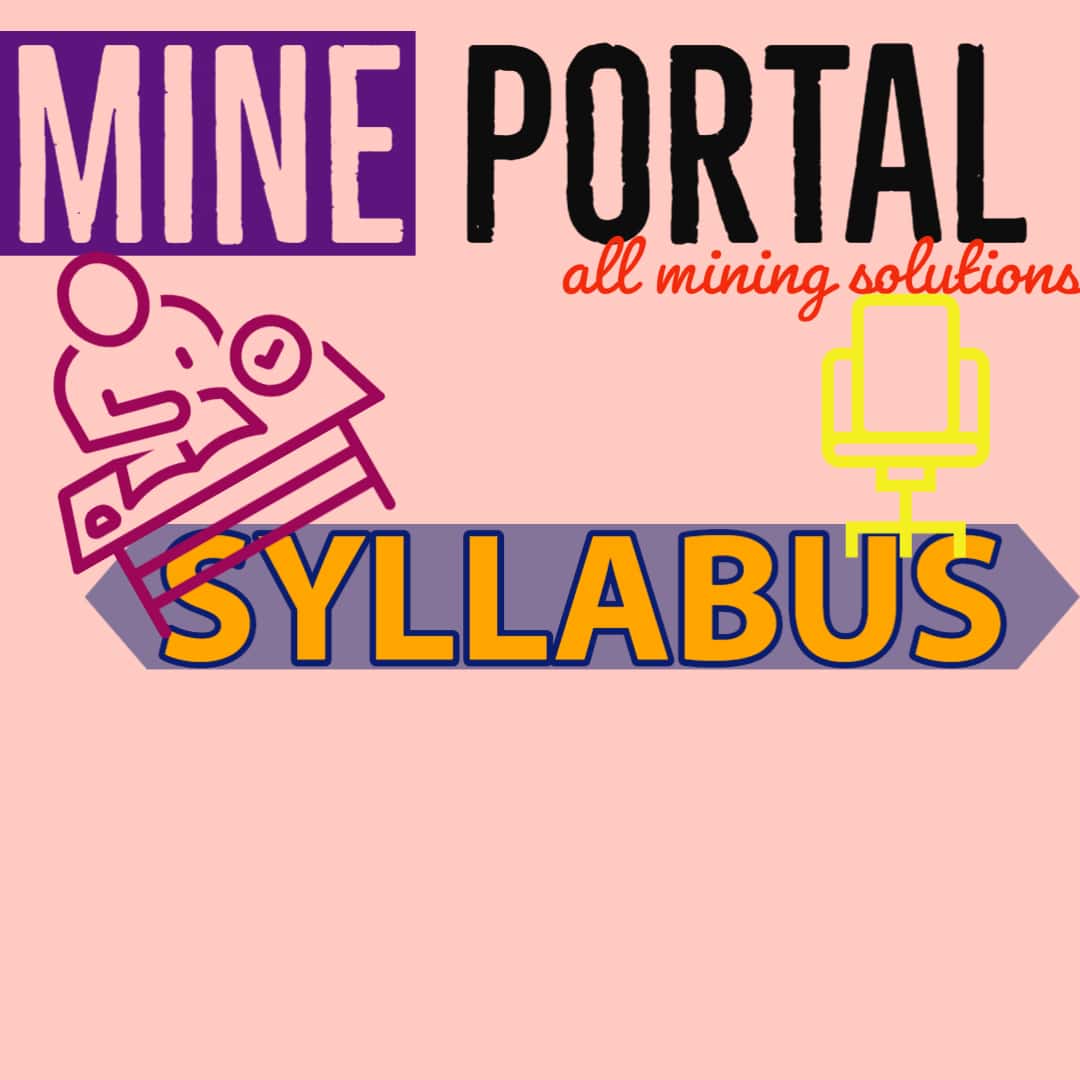
GATE- MINING 2021 EXAM SYLLABUS
SYLLABUS OF GATE MINING 2021 EXAM
Yellow Highlighted Topics are new addition in Mining GATE 2021 Syllabus
GENERAL APTITUDE
(No major changes in VERBAL Aptitude and Quantitative Aptitude Paper syllabus only thing is that it has been elaborated in details)
Verbal Aptitude:Basic English grammar: tenses, articles, adjectives, prepositions, conjunctions, verb-noun agreement, and other parts of speech , Basic vocabulary: words, idioms, and phrases in context
Reading and comprehension ,Narrative sequencing
Quantitative Aptitude: Data interpretation: data graphs (bar graphs, pie charts, and other graphs representing data), 2- and 3-dimensional plots, maps, and tables
Numerical computation and estimation: ratios, percentages, powers, exponents and logarithms, permutations and combinations, and series ,Mensuration and geometry, Elementary statistics and probability
Analytical Aptitude Logic: deduction and induction Analogy Numerical relations and reasoning
Spatial Aptitude: Transformation of shapes: translation, rotation, scaling, mirroring, assembling, and grouping Paper folding, cutting, and patterns in 2 and 3 dimensions
Section
1: Engineering Mathematics:
Linear
Algebra: Matrices and Determinants; Inverse and Rank of matrix; Systems of linear
equations; Eigen values and Eigen vectors. Cayley-Hamilton Theorem.
Calculus: Limit,
continuity and differentiability; Partial Derivatives; Mean value theorems; Indeterminate forms and L’
Hospital’s rule; Maxima and minima; Taylor’s theorem; Sequences and series; Test for
convergence;Fourier series.
Vector
Calculus: Gradient; Divergence and Curl; Line; surface and volume
integrals; Stokes, Gauss and Green’s theorems.
Diferential
Equations: Linear and non-linear first order ODEs; Higher order linear
ODEs with constant coefficients; Cauchy’s and Euler’s equations.
Probability
and Statistics: Measures of central tendency and dispersion; hypothesis testing;
Binomial, Poisson, exponential
and normal distributions; Correlation and regression analysis.
Numerical Methods: Solutions of linear algebraic equations; Interpolation; Integration of trapezoidal and Simpson’s rule; Single and multi-step methods for differential equations.
Section
2: Mining Geology, Mine Development and Surveying:
Mining Geology: Minerals, Rocks and their Origin, Classification, Ore Genesis;
Structural Geology.
Mine
Development: Methods of access to deposits; Underground drivages;
Drilling methods and machines; Explosives and energetics, blasting devices, blast design practices;
Rock-Tool Interaction applicable to mechanical cutting systems and their
selection.
Mine
Surveying: Levels and levelling, theodolite, tacheometry,
triangulation; Contouring; Errors andadjustments; Correlation; Underground
surveying; Curves; Photogrammetry; EDM, Total Station, GPS, Basics of GIS and remote sensing.
Section
3: Geomechanics and Ground Control:
Engineering
Mechanics: Equivalent force systems; Equations of equilibrium; Two
dimensional frames and trusses; Free body diagrams; Friction forces; Particle
kinematics and dynamics; Beam analysis.
Geomechanics:
Geo-technical properties of rocks; Rock mass classification; Instrumentation
and in-situ stress measurement techniques; Theories of rock failure; Ground
vibrations; Stress distribution around mine openings; Subsidence; Slope
stability.
Ground
Control: Design of pillars; Roof supporting systems; Mine filling. Strata Control and Monitoring
Plan.
Section
4: Mining Methods and Machinery:
Mining
Methods: Surface mining: layout, development, loading,
transportation and mechanization, continuous surface mining systems; highwall
mining; Underground coal mining: bord and pillar systems, room and pillar mining,
longwall mining, thick seam mining methods, Underground metal mining: open,
supported and caved stoping methods, stope mechanization, ore handling systems.
Mining
Machinery: Generation and transmission of mechanical, hydraulic and
pneumatic power; Materials handling: wire ropes, haulages, conveyors, face and development machinery,
hoisting systems, pumps; comminution
methods and machinery.
Section
5: Surface Environment, Mine Ventilation and Underground Hazards:
Surface Environment: Air, water and soil pollution: Standards
of quality, causes and dispersion of contamination and control; Noise pollution and control;
Land reclamation; EIA.
Mine
Ventilation: Underground atmosphere; Heat load sources and thermal
environment,; air cooling; Mechanics of airflow, distribution, natural and
mechanical ventilation; Mine fans and their usage; Auxiliary ventilation;
Ventilation survey and planning; Ventilation networks.
Underground
Hazards: Mine Gases, Methane drainage; Underground hazards from fires, explosions,
dust and inundation; Rescue apparatus and practices; Safety management plan; Accident data
analysis; assessment; Mine lighting; Mine legislation; Occupational health and safety.
Section
6: Mineral Economics, Mine Planning, Systems Engineering:
Mineral
Economics: Mineral resource classification; Discounted cash flow
analysis; Mine valuation; Mineral taxation.
Mine
Planning: Sampling methods, practices and interpretation; Reserve
estimation techniques: Basics of geostatistics and quality control;
Optimization of facility location; Mine planning and its components, Determination of mine size and mine
life; Ultimate pit configuration and its determination, Optimum mill cut-off grade
and its determination, Stope planning, Design of haul road, Selection of mining
system vis-à-vis equipment system.
Systems Engineering: Concepts of reliability; Reliability of simple systems; Maintainability and availability; Linear programming, transportation and assignment problems; Network analysis; Inventory models; Queuing theory; Decision trees.


No comments added yet!